Risako Miura
Department:
Energy and Hydrocarbon Chemistry
Keywords:
Bioimaging, Polysaccharide, Nanoparticle, Photoacoustic imaging
Email:
miura.risako.8x at kyoto-u.ac.jp
Homepage:
https://researchmap.jp/r_miura
While cancer immunotherapy has been attracting attention with low side effects and high complete response rate, some tumor, called cold tumor, does not respond to immunotherapy. Cold tumor shows immunosuppressive tumor microenvironment with low T cell migration and a lot of distribution of M2 macrophages. Here, we aim to early diagnose and treat of cold tumor by developing near infrared and photoacoustic imaging contrast agents.
Photoacoustic imaging is a new imaging modality, which enables deep-tissue and non-invasive imaging, by detecting ultrasonic waves which generated by the repeated thermal expansion and contraction of pulsed laser irradiated light absorbers. Near-infrared dyes are generally used for photoacoustic imaging contrast agents, but they often show hydrophobicity, and then developing the delivery systems are needed for in vivo application.
We have developed Pullulan-Mannose-IR820 (PMI) nanogel as the stable delivery carrier of near-infrared dyes to cold tumor specifically. PMI consists of pullulan as hydrophilic polysaccharide, mannose as M2 macrophage targeting moiety, and IR-820 as hydrophobic near-infrared dye. PMI was shown to form self-assembled nanogels in water by the hydrophobic interaction of IR-820 and to function as a photoacoustic probe. Furthermore, the modification of mannose enhanced the active interaction with M2 macrophages and improved the photoacoustic contrast of tumors by enhancing tumor accumulation.
PMI nanogels can be complexed with hydrophobic molecules at hydrophobic cross-linking points. We are now planning to develop PMI nanogel-based theranostics (therapy + diagnostics) drugs that can simultaneously realize photoacoustic imaging and chemotherapy or immunotherapy by conjugating hydrophobic small molecule drugs (anti-cancer drugs and adjuvants).
